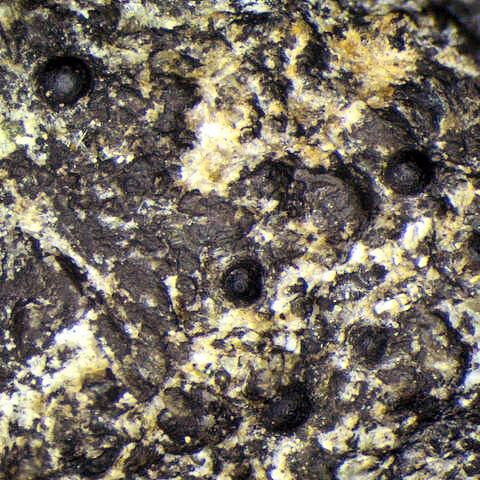Atla alpina Savić & Tibell
Lichenologist, 40: 273, 2008.
Synonyms: Polyblastia theleodes (Sommerf.) Th. Fr. var. inundata Nyl. ex Th. Fr.; Polyblastia theleodes auct. p.p.
Distribution: N - Ven (B-60 0195311), TAA (Nascimbene & al. 2022), Lomb, Piem (Isocrono & al. 2004), VA (Piervittori & Isocrono 1999).
Description: Thallus crustose, episubstratic, thin to well-developed, continuous or minutely areolate, grey to dark greenish grey, sometimes partly immersed and forming small dark patches. Perithecia glossy black, forming hemispherical projections, 0.6-0.8(-1) mm across, with a rough surface, rarely with a very thin thalline collar at the base, the ostiolar region usually depressed. Involucrellum more or less fused with exciple, or somewhat diverging in lower part, thicker around the ostiole; exciple 15-25 μm thick, brown, paler in lower part; hamathecium of periphyses and periphysoids, interascal filaments absent; periphysoids numerous, slender, 1.5-2.5 μm wide; hymenial gel hemiamyloid, I+ red (+ blue at very low concentrations of I), K/I+ blue. Asci 8-spored, broadly ellipsoid to clavate, K/I-, fissitunicate, wall thickened above when young. Ascospores muriform, dark brown when mature, the cells outlines mostly obscured, ellipsoid to broadly ellipsoid, 63-85(-95) x 35-50 μm. Photobiont chlorococcoid, but verrucose cephalodia with Nostoc frequent. Spot tests: K-, C-, KC-, P-, UV-. Chemistry: without lichen substances.Note: in the central European mountains A. alpina grows on calcareous rocks (mesozoic limestone, marble of variable age) with at least locally increased humidity; it is widely distributed in the Alps and not at all rare: probably a considerable percentage of the records of Henrica theleodes, especially those upon pure limestone, refer to this species.
Growth form: Crustose
Substrata: rocks
Photobiont: green algae other than Trentepohlia
Reproductive strategy: mainly sexual
Commonnes-rarity: (info)
Alpine belt: rather rare
Subalpine belt: rare
Oromediterranean belt: absent
Montane belt: extremely rare
Submediterranean belt: absent
Padanian area: absent
Humid submediterranean belt: absent
Humid mediterranean belt: absent
Dry mediterranean belt: absent

Predictive model
Herbarium samples
Growth form: Crustose
Substrata: rocks
Photobiont: green algae other than Trentepohlia
Reproductive strategy: mainly sexual
Commonnes-rarity: (info)
Alpine belt: rather rare
Subalpine belt: rare
Oromediterranean belt: absent
Montane belt: extremely rare
Submediterranean belt: absent
Padanian area: absent
Humid submediterranean belt: absent
Humid mediterranean belt: absent
Dry mediterranean belt: absent

Predictive model
| Herbarium samples |
 INDEX FUNGORUM
INDEX FUNGORUM
 GBIF
GBIF
 DOLICHENS
DOLICHENS


